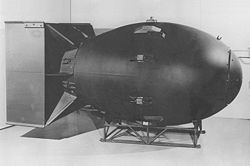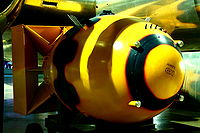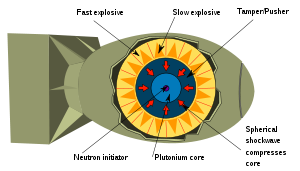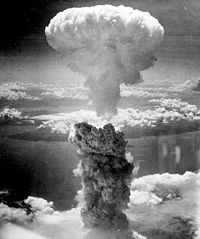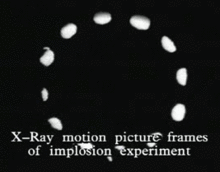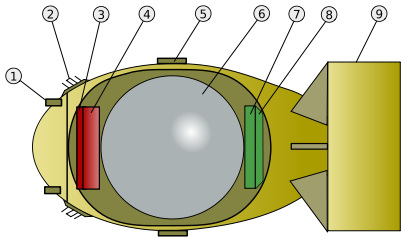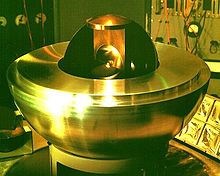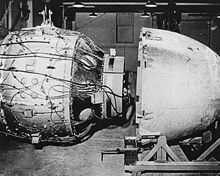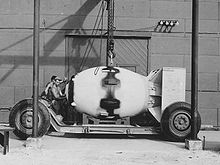- Fat Man
-
This article is about the World War II nuclear weapon. For other uses, see Fat Man (disambiguation).
Fat Man (Atomic Bomb)
Mockup of the original weaponType Nuclear weapon Place of origin United States Specifications Weight 10,213 pounds (4,633 kg) Length 10.7 feet (3.3 m) Diameter 5 feet (1.5 m) Blast yield 21 kt (88 TJ) ~75 Million sticks of dynamite. "Fat Man" is the codename for the atomic bomb that was detonated over Nagasaki, Japan, by the United States on August 9, 1945. It was the second of the only two nuclear weapons to be used in warfare to date (the other being "Little Boy"), and its detonation caused the third man-made nuclear explosion. The name also refers more generically to the early nuclear weapon designs of U.S. weapons based on the "Fat Man" model. It was an implosion-type weapon with a plutonium core, similar to "The gadget", the experimental device detonated only a month earlier in New Mexico.[1]
"Fat Man" was possibly named after Winston Churchill,[2] though Robert Serber said in his memoirs that as the "Fat Man" bomb was round and fat, he named it after Sydney Greenstreet's character of "Kasper Gutman" in The Maltese Falcon.
"Fat Man" was dropped from the B-29 bomber Bockscar, piloted by Major Charles Sweeney of the 393d Bombardment Squadron, Heavy, and exploded at 11:02 AM (JST), at an altitude of about 1,650 feet (500 m), with a yield of about 21 kilotons of TNT or 88 terajoules.[3] Because of poor visibility due to cloud cover, the bomb missed its intended detonation point, and damage was somewhat less extensive than that in Hiroshima. An estimated 39,000 people were killed outright by the bombing at Nagasaki, and a further 25,000 were injured.[4] Thousands more died later from related blast and burn injuries, and hundreds more from radiation illnesses from exposure to the bomb's initial radiation. The bombing raid on Nagasaki had the third highest fatality rate in World War II[5] after the nuclear strike on Hiroshima[6][7][8][9] and the March 9/10 1945 fire bombing raid on Tokyo.[10]
Contents
Technology
It was 128 inches (3,300 mm) long, 5 feet (1.5 m) in diameter, and weighed 10,200 pounds (4,600 kg). In accordance with the name, it was more than twice as wide as Little Boy, which was dropped on Hiroshima three days earlier; however, the mass was only 15% more than that of Little Boy.
"Fat Man" was an implosion-type device using plutonium-239. A subcritical sphere of plutonium was placed in the center of a hollow sphere of high explosives. Thirty-two pairs of detonators located on the surface of the high explosive were fired simultaneously to produce a powerful inward pressure on the core, squeezing it and increasing its density, resulting in a supercritical condition and a nuclear initiation.
At first it was thought that two pieces of subcritical plutonium (Pu-239) could simply be shot into one another to create a nuclear explosion, and a plutonium gun-type design of this sort (known as the "Thin Man" bomb) was worked on for some time during the Manhattan Project. In April 1944, Emilio Segrè discovered that plutonium created for the bomb in the nuclear reactors at Hanford, Washington—even though it was supergrade plutonium containing only about 0.9% Pu-240—was not as pure as the initial samples of plutonium developed at the cyclotrons at Ernest O. Lawrence's Radiation Laboratory in Berkeley, California. Because of the presence of the Pu-240 isotope, reactor-bred plutonium had a much higher rate of spontaneous neutron emission than was previously thought, and if a gun-type device was used it would most likely pre-initiate and result in a messy and costly "fizzle". The spontaneous fission rate of Pu-240 is 40,000 times greater than that of Pu-239, so that in a gun-type plutonium device of the sort planned during the Manhattan Project, the last few centimeters would have to be traveled in less than 40 microseconds. After this problem was realized, the entire Los Alamos laboratory re-organized around the problem of the implosion bomb, the "Fat Man" starting in June 1944.
The difficulty in the design of an implosion device lay primarily in properly compressing the plutonium core into a near-perfect sphere; if the compression was not symmetrical it would cause the plutonium to be ejected from the weapon, making it an inefficient "dirty bomb". In order to accomplish the compression, the high explosive system had to be carefully designed as a series of explosive lenses which used alternating fast- and slow-burning explosives to shape the explosive shock wave into the desired spherical shape. An early idea of this sort had been raised by physicist Richard Tolman during early discussions of possible bomb designs, specifically in having many pieces of fissile material attached to explosives that would then assemble them in a spherical fashion. This idea was further developed by Seth Neddermeyer, who attempted to find a way to collapse a hollow sphere of plutonium onto a solid sphere of it inside itself. Neither of these ideas relied on compression of the plutonium, and neither would assemble the device fast enough to avoid preinitiation (see discussion below).[11]
The idea of using shaped charges came from James L. Tuck[12] and was developed by mathematician John von Neumann,[13] and the idea that under such pressures the plutonium metal itself would be compressed may have come about from conversations with Edward Teller, whose knowledge of how dense metals behaved under heavy pressure was influenced by his theoretical studies of the Earth's core with George Gamow.[11] Von Neumann and George Kistiakowsky eventually became the principal architects behind the lens system. Robert Christy is credited with doing the final calculations that showed that a solid subcritical sphere of plutonium could be compressed to a critical state greatly simplifying the task since earlier efforts had attempted the more difficult compression of 3D shapes like spherical shells. After Christy's report, the solid-plutonium core weapon was referred to as the "Christy Gadget".
Because of its complicated firing mechanism, and the need for previously untested synchronization of explosives and precision design, it was felt that a full test of the concept was needed before the scientists and military representatives could be confident it would perform correctly under combat conditions. On July 16, 1945, a device using a similar mechanism (called the "gadget" for security reasons) detonated in a test explosion at a remote site in New Mexico, known as the "Trinity" test. It gave about 20 kt (80 TJ), 2 to 4 times the expected yield.
The gun-type method, though inadequate for plutonium, could still be used for highly enriched uranium, and was employed in the "Little Boy" device, used against Hiroshima. The implosion method is more efficient than the gun-type method, and also far safer, as a perfect synchronization of the explosion lenses is required for the core to properly detonate, greatly reducing the chances of an accidental nuclear initiation. After the success of the first implosion "gadget", almost all subsequent American fission designs utilized implosion, with a rare few that used the gun-type design out of special design requirements (like extreme narrowness of weapon, such as nuclear artillery).
 Espionage information procured by Klaus Fuchs and Theodore Hall, and to a lesser extent David Greenglass, led to the first Soviet device, "RDS–1" (above) closely resembling Fat Man, even in its external shape.
Espionage information procured by Klaus Fuchs and Theodore Hall, and to a lesser extent David Greenglass, led to the first Soviet device, "RDS–1" (above) closely resembling Fat Man, even in its external shape.
The Soviet Union's first nuclear weapon detonated at Operation First Lightning (known as "Joe 1" in the West) was closely based on the "Fat Man" device, on which they had obtained detailed information from the spies Klaus Fuchs, Theodore Hall, and David Greenglass.[14][15]
The names for all three projects ("Fat Man", "Thin Man", and "Little Boy") were allegedly created by Robert Serber, a former student of Los Alamos director Robert Oppenheimer who worked on the project, according to Serber. According to his later memoirs, he chose them based on their design shapes; the "Thin Man" would be a very long device, and the name came from the Dashiell Hammett detective novel and series of movies by the same name; the "Fat Man" bomb would be round and fat and was named after Sidney Greenstreet's "Kasper Gutman" character in The Maltese Falcon. "Little Boy" would come last and be named only to contrast to the "Thin Man" bomb.[16]
Other sources say the names originated with the Army Air Forces. According to this version, the B-29 bombers would need certain modifications to enable them to carry the weapons. A cover story was created that the modifications were to fit out two B-29s as transportation aircraft for President Franklin D. Roosevelt and British Prime Minister Winston Churchill. The "Fat Man" was supposedly Churchill, the "Thin Man", Roosevelt.[17] When it was discovered that the gun-bomb could be shorter than first thought, "Thin Man" was renamed "Little Boy."
After the war, the Fat Man (technically the model 1561 Fat Man) was modified—improved detonators, a more reliable firing system, and other minor changes. It thus emerged as the Mark III (or Mark 3) atomic bomb. Approximately 100 units were added to the arsenal before retirement by 1950.
Interior of bomb
The original blueprints of the interior of both Fat Man and Little Boy have been classified since World War II. However, much information about the main parts is available in the unclassified public literature. Of particular interest is a description of Fat Man sent to Moscow by Soviet spies at Los Alamos in 1945. It was released by the Russian government in 1992.[18]
Below is a diagram of the main parts of the "Fat Man" device itself, followed by a more detailed look at the different materials used in the physics package of the device (the part responsible for the nuclear initiation).
- AN 219 contact fuze (four)
- Archie radar antenna
- Plate with batteries (to detonate charge surrounding nuclear components)
- X-Unit, a firing set placed near the charge
- Hinge fixing the two ellipsoidal parts of the bomb
- Physics package (see details below)
- Plate with instruments (radars, baroswitches and timers)
- Barotube collector
- California Parachute tail assembly (0.20-inch (5.1 mm) aluminium sheet)
Physics package

Assembly
To allow insertion of the 3.62 inch (92 mm) diameter plutonium pit, containing the 0.83 inch (21 mm) diameter "Urchin" initiator, as late as possible in the device's assembly, the spherical 8.75 inch (222 mm) diameter U-238 tamper surrounded by a 0.125 inch (3.2 mm) thick shell of boron impregnated plastic had a 5 inch (130 mm) diameter cylindrical hole running through it, like the hole in a cored apple. The missing U-238 tamper cylinder, containing the plutonium pit, could be slipped in through a hole in the surrounding 18.5 inch (470 mm) diameter aluminium pusher.
In August 1945, it was assembled on Tinian Island. When the physics package was fully assembled and wired, it was placed inside its ellipsoidal aerodynamic bombshell and wheeled to the bomb bay of the B-29 Superfortress named "Bockscar", after its normally assigned command pilot, Fred Bock (who flew a different plane on the Nagasaki mission).[19]
In 2003, these concentric spheres and cylinder were recreated as the centerpiece of an art installation called Critical Assembly by sculptor Jim Sanborn. Using non-nuclear materials, he replicated the internal components of the "Trinity" device, which had the same design as Fat Man. Critical Assembly was first displayed at the Corcoran Gallery of Art, in Washington, DC.[20]
The plutonium must be compressed to twice its normal density before free neutrons are added to start the fission chain reaction:
-
An exploding-bridgewire detonator simultaneously starts a detonation wave in each of the 32 tapered high explosive columns (pentagons and hexagons arranged as on a soccer ball—a truncated icosahedron).
-
The detonation wave (arrows) is initially convex in the
-
faster explosive, Composition B: 60% RDX, 39% TNT, 1% wax. The wavefront shape becomes concave in the
-
slower explosive (Baratol). The 32 waves merge into a single spherical implosive wave before they hit the
-
The medium-density aluminium "pusher" transfers the imploding shock wave from low-density explosive to high-density uranium, minimizing undesirable turbulence; the shock wave then compresses the inner components. At the very center, the
-
natural-uranium "tamper" (inertial containment). The tamper also reflects neutrons back into the pit, speeding up the chain reaction.
-
The boron plastic shell was intended to protect the pit from stray neutrons, but was later deemed unnecessary.
The result was that in the Fat Man bomb, about 1 kilogram (2.2 lb) of the 6.2 kilograms (14 lb) of plutonium in the pit (about 17%) fissioned. In this process 1 gram (0.035 oz) of matter in the bomb was converted into the active energy of heat and radiation (see mass-energy equivalence for detail), releasing the energy equivalent of 21 kilotons of TNT or 88 terajoules.
See also
- Atomic bombings of Hiroshima and Nagasaki
- Bockscar
- Enola Gay
- Fat Man and Little Boy, a 1989 film that reenacts the Manhattan Project
- The gadget
- Little Boy
- RDS-1, the first Soviet atomic device, closely modeled after "Fat Man"
- Thin Man nuclear bomb
- Trinity test
- Tsar Bomba aka Kuzka's mother
References
- ^ Hakim, Joy (1995). A History of Us: War, Peace and all that Jazz. New York: Oxford University Press. ISBN 0-19-509514-6.
- ^ "1945: Atom bomb hits Nagasaki". BBC News. August 9, 1945. http://news.bbc.co.uk/onthisday/hi/dates/stories/august/9/newsid_3580000/3580143.stm. Retrieved May 2, 2010.
- ^ What was the yield of the Hiroshima bomb?
- ^ The Avalon Project : The Atomic Bombings of Hiroshima and Nagasaki
- ^ The Atomic Bombing of Nagasaki, August 9, 1945
- ^ Health Risks from Exposure to Low Levels of Ionizing Radiation: BEIR VII Phase 2
- ^ Frequently Asked Questions - Radiation Effects Research Foundation
- ^ Radiobiology for the radiologist. Lippincott Williams & Wilkins, 6th edition. Chapter 10, Sections 3,4,5.
- ^ The Atomic Bombing of Hiroshima, August 6, 1945
- ^ Richard B. Frank, Downfall, p. 17–18.
- ^ a b Edward Teller, Memoirs: A Twentieth-Century Journey in Science and Politics (Cambridge, MA: Perseus Publishing, 2001): 174-176.
- ^ Tuck at Los Alamos web site
- ^ Von neuman at Los Alamos web site
- ^ Holloway, David (1993). "Soviet Scientists Speak Out". Bulletin of the Atomic Scientists (Educational foundation for Nuclear Science) 49 (4): 18–19. http://books.google.com/books?id=qQwAAAAAMBAJ&pg=PA18#v=onepage&q&f=false. Retrieved August 14, 2011.
- ^ Carey Sublette (July 3, 2007). "The Design of Gadget, Fat Man, and "Joe 1" (RDS-1)". Nuclear Weapons FAQ. http://www.nuclearweaponarchive.org/Nwfaq/Nfaq8.html#nfaq8.1.1. Retrieved 12 August 2011.
- ^ Robert Serber, Peace & War: Reminiscences of a Life on the Frontiers of Science (New York: Columbia University Press, 1998): 104.
- ^ Paul W Tibbets, Clair C Stebbins, and Harry Franken, The Tibbets Story (New York; Stein and Day, 1978. ISBN 9780812821574)
- ^ V.P. Visgin, ed. 1992. At the source of the Soviet atomic project: the role of espionage, 1941-1946. Problems in the History of Science and Technology 3:97. Described in Richard Rhodes, Dark Sun: The Making of the Hydrogen Bomb. Simon and Schuster, 1995. pp. 193-8.
- ^ http://awesometalks.wordpress.com/2008/08/07/bockscar-the-forgotten-plane-that-dropped-the-atomic-bomb/
- ^ Jim Sanborn, Atomic Time: Pure Science and Seduction, Jonathan Binstock, ed., Corcoran Gallery of Art, 2003, p. 23.
External links
- thorough descriptions of Gadget ("a great deal of tissue paper and Scotch tape were used to make everything fit snugly") and Fat Man at Nuclear Weapons Archive
- The Design of Gadget, Fat Man, and "Joe 1" (RDS-1)
- Fat Man Model in QuickTime VR format
- Naming of "Fat Man" & "Thin Man" after Churchill, Roosevelt
- The final bomb design, with pictures
- Atomic John: A truck driver uncovers secrets about the first nuclear bombs. Essay and interview with John Coster-Mullen by David Samuels in the New Yorker, December 15, 2008 issue. Coster-Mullen is the author of Atom Bombs: The Top Secret Inside Story of Little Boy and Fat Man, 2003 (first printed in 1996, self-published), considered a definitive text about Fat Man; illustrations from which are used in the Physics Package section above.
Manhattan Project Sites 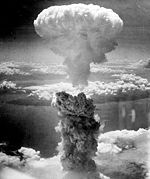
Administrators Vannevar Bush · James Conant · Thomas Farrell · Leslie Groves · Franklin Matthias · Kenneth Nichols · Robert Oppenheimer · William ParsonsScientists Hans Bethe · Niels Bohr · James Chadwick · Arthur Compton · Enrico Fermi · Richard Feynman · Klaus Fuchs · George Kistiakowsky · Ernest Lawrence · William Penney · Emilio G. Segrè · Glenn T. Seaborg · Leó Szilárd · Edward Teller · Richard C. Tolman · Stanislaw Ulam · Harold Urey · Leona Woods · Chien-Shiung WuRelated articles Timeline · History of nuclear weapons · Nuclear weapons and the United States · S-1 Uranium Committee · Chicago Pile-1 · X-10 Graphite Reactor · Y-12 National Security Complex · Operation Alsos · Smyth Report · Project Alberta · 509th Operations Group · Fat Man · Little Boy · Enola Gay · Bockscar · The Great Artiste · Atomic bombings of Hiroshima and Nagasaki (debate) · Atomic Spies · Atomic Energy Act of 1946 · Operation Crossroads · Tube AlloysWorld War II Participants Timeline Aspects GeneralWar crimes- German and Wehrmacht war crimes
- The Holocaust
- Italian war crimes
- Japanese war crimes
- Unit 731
- Allied war crimes
- Soviet war crimes
- United States war crimes
- German military brothels
- Camp brothels
- Rape during the occupation of Japan
- Comfort women
- Rape of Nanking
- Rape during the occupation of Germany
- Nazi crimes against Soviet POWs
- Italian prisoners of war in the Soviet Union
- Japanese prisoners of war in the Soviet Union
- Japanese prisoners of war in World War II
- German prisoners of war in the Soviet Union
- Finnish prisoners of war in the Soviet Union
- Polish prisoners of war in the Soviet Union
- Romanian prisoners of war in the Soviet Union
- German prisoners of war in the United States
Coordinates: 32°46′25.5″N 129°51′47.5″E / 32.77375°N 129.863194°E
Categories:- Manhattan Project
- Nuclear bombs of the United States
- Atomic bombings of Hiroshima and Nagasaki
- Cold War nuclear bombs of the United States
- World War II weapons of the United States
- Code names
Wikimedia Foundation. 2010.

